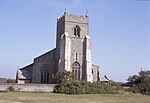St Nicholas, Blakeney

St Nicholas is the Anglican parish church of Blakeney, Norfolk, in the deanery of Holt and the Diocese of Norwich. The church was founded in the 13th century, but the greater part of the church dates from the 15th century when Blakeney was a seaport of some importance. Of the original structure only the chancel has survived rebuilding, perhaps owing to its link to a nearby Carmelite friary. An unusual architectural feature is a second tower, used as a beacon, at the east end (the church stands just inland from, and about 30 metres (98 ft) above, the small port). Other significant features are the vaulted chancel with a stepped seven-light lancet window, and the hammerbeam roof of the nave. St Nicholas is a nationally important building, with a Grade I listing for its exceptional architectural interest. Much of the original church furniture was lost in the Reformation, but a late-Victorian restoration recreated something of the original appearance, as well as repairing and refacing the building. The Victorian woodwork was created to match the few older pieces that remained, or to follow a similar style; thus, the new wooden pulpit follows the themes of the medieval font. Of the stained glass smashed in the Reformation only fragments have been recovered, and these have been incorporated in a window in the north aisle of the church. Nine Arts and Crafts windows by James Powell and Sons are featured on the east and south sides of the church, and the north porch has two modern windows of predominantly blue colour. St Nicholas contains some notable memorials, including several plaques for the Blakeney lifeboats and their crews, and much pre-Reformation graffiti, particularly depictions of ships. The location of the latter suggests that they were votive in nature, although the saint concerned is now unknown.
Excerpt from the Wikipedia article St Nicholas, Blakeney (License: CC BY-SA 3.0, Authors, Images).St Nicholas, Blakeney
Coast Road, North Norfolk Blakeney
Geographical coordinates (GPS) Address Nearby Places Show on map
Geographical coordinates (GPS)
| Latitude | Longitude |
|---|---|
| N 52.951111111111 ° | E 1.0247222222222 ° |
Address
Coast Road
NR25 7UE North Norfolk, Blakeney
England, United Kingdom
Open on Google Maps










